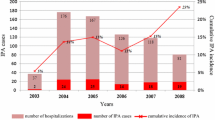Abstract
The control of microbial air contamination in hospital wards has assumed great importance particularly for those hospital infections where an airborne infection route is hypothesised, such as aspergillosis. Invasive aspergillosis represents one of the most serious complications in immunocompromised patients. For some authors there is a direct association between this pathology and the concentrations of Aspergillus conidia in the air; in addition, reports of aspergillosis concurring during building construction have been frequent. In this study, two haematology wards were monitored for about 2 years in order to make both a qualitative and quantitative evaluation of fungal burden in the air, also in relation to major construction and demolition work taking place in the same building. Air samples were taken from the hospital rooms of neutropenic patients, in the corridors of their ward and outside the building. Total fungal concentration resulted higher outside (mean 572 Colony Forming Units/m3 of air), lower in the corridors (147CFU/m3) and even lower in the rooms (50 CFU/m3). In all the samples we found the development of at least one fungal colony. Cladosporium was the most frequently isolated genus (57%), in contrast to Aspergillus spp. (2%). The average concentration of Cladosporium spp. was 24 CFU/m3 in the rooms, 78 CFU/m3 in the corridors and 318 CFU/m3 outside. The average concentration of Aspergillus spp. was 1.2 CFU/m3 in the rooms, 3.5 CFU/m3 in the corridors, 5.6 CFU/m3 outside. Our observations show low concentrations of Aspergillus fumigatus and A. flavus in all the environments examined and particularly in the rooms (0.09 and 0.10 CFU/m3 respectively); this observation could explain the absence of cases of invasive aspergillosis during the period of air monitoring in the two haematology wards.
Similar content being viewed by others
References
Reynolds SJ, Black DW, Borin SS, et al. Indoor environmental quality in six commercial office buildings in the midwest United States. Appl Occup Environ Hyg 2001; 16: 1065–1077.
Parat S, Perdrix A, Baconnier P. Relationships between air conditioning, airborne microorganisms and health. Bull Acad Natl Med 1999; 183: 327–342.
Brusaferro S. Infezioni ospedaliere: modelli epidemiologici e strategie di prevenzione. Ann Ig 2001; 13(Suppl 2): 3–19.
Privitera G, Panceri ML, Castaldi S, Auxilia F. Il costo delle infezioni ospedaliere in Italia. Ann Ig 1998; 10(Suppl 2): 273.
Arnow PM, Andersen RL, Mainous PD, Smith EJ. Pulmonary aspergillosis during hospital renovation. Am Rev Respir Dis 1978; 118: 49–53.
Germaud P, Haloun A. Invasive nosocomial aspergillosis. Rev Pneumol Clin 2001; 57: 157–163.
Arnow PM, Sadigh M, Costas C, Weil D, Chudy R. Endemic and epidemic aspergillosis associated with inhospital replication of Aspergillus organisms. J Inf Dis 1991; 164: 998–1002.
Nolard-Tintigner N, Snoeck R, Leleux A, Beguin H, Moonens F, Meunier-Carpentier F. Mise en evidence d'Aspergillus fumigatus lors de travaux de construction et de rénovation en milieu hospitalier. Bull Soc Fr Mycol Méd 1985; 14: 93–98.
Oren I, Haddad N, Finkelstein R, Rowe JM. Invasive pulmonary aspergillosis in neutropenic patients during hospital construction: Before and after chemoprophylaxis and institution of HEPA filters. Am J Hematol 2001; 66: 257–262.
Nolard N. Les liens entre les risques d'aspergillose et la contamination de l'environnement. Path Biol 1994; 42: 706–710.
Barnes RA, Rogers TR. Control of an outbreak of nosocomial aspergillosis by laminar air-flow isolation. J Hosp Infect 1989; 14: 89–94.
Bodey G, Bueltmann B, Duguid W, et al. Fungal infections in cancer patients: An international autopsy survey. Eur J Clin Microbiol Infect Dis 1992; 11: 99–109.
Sherertz RJ, Belani A, Kramer BS, et al. Impact of air filtration on nosocomial Aspergillus infections. Unique risk of bone marrow transplant recipients. Am J Med 1987; 83: 709–718.
Rogers TR. Infections in hematologic malignancy. Infect Control 1986; 7(Suppl 2): 140–143.
Aisner J, Wiernik PH, Schimpff SC. Treatment of invasive aspergillosis: Relation of early diagnosis and treatment to response. Ann Intern Med 1977; 86: 539–543.
Klont RR, Meis JFGM, Verweij PE. Critical assessment of issues in the diagnosis of invasive aspergillosis. Clin Microbiol Infect 2001; 7(Suppl 2): 32–37.
Jantuen E, Piilonen A, Volin L, et al. Diagnostic aspects of invasive Aspergillus infections in allogenic BMT recipients. Bone Marrow Trasplant 2000; 25: 867–871.
Lin SJ, Schranz J, Teutsch SM. Aspergillosis casefatality rate: Systematic review of the literature. Clin Infect Dis 2001; 32: 358–366.
White MH, Anaissie EJ, Kusne S, et al. Amphotericin B colloidal dispersion vs. amphotericin B as therapy for invasive aspergillosis. Clin Infect Dis 1997; 24: 635–642.
Denning DW. Therapeutic outcome in invasive aspergillosis. Clin Infect Dis 1996; 23: 608–615.
Daniau C, Kauffmann-Lacroix C, Castel O. L'aérobiocontamination fongique en milieu hospitalier. J Mycol Méd 1998; 8: 139–146.
Leenders A, Van Belkum A, Behrendt M, Luijendijk AD, Verbrugh H. Density and molecular epidemiology of Aspergillus in air and relationship to outbreaks of Aspergillus infection. J Clin Microbiol 1999; 37: 1752–1757.
Goodley JM, Clayton YM, Hay RJ. Environmental sampling for aspergilli during building construction on a hospital site. J Hosp Infect 1994; 26: 27–35.
Mullins J, Hutcheson PS, Slavin RG. Aspergillus fumigatus spore concentration in outside air: Cardiff and St Louis compared. Clin Allerg 1984; 14: 351–354.
Jones BL, Cookson JT. Natural atmospheric microbial conditions in a typical suburban area. Appl Environ Microbiol 1983; 45: 919–934.
Mahieu LM, De Dooy JJ, Van Laer FA, Jansens H, Ieven MM. A prospective study on factors influencing Aspergillus spore load in the air during renovation works in a neonatal intensive care unit. J Hosp Infect 2000; 45: 191–197.
Alberti C, Bouakline A, Ribaud P, et al. Relationship between environmental fungal contamination and the incidence of invasive aspergillosis in Haematology patients. J Hosp Infect 2001; 48: 198–206
Author information
Authors and Affiliations
Corresponding author
Rights and permissions
About this article
Cite this article
Pini, G., Donato, R., Faggi, E. et al. Two Years of a Fungal Aerobiocontamination Survey in a Florentine Haematology Ward. Eur J Epidemiol 19, 693–698 (2004). https://doi.org/10.1023/B:EJEP.0000036778.13006.16
Issue Date:
DOI: https://doi.org/10.1023/B:EJEP.0000036778.13006.16




